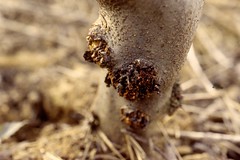The dogwood borer, Syanthedon scitula (Harris) (fig. 1), is from the Family Sesiidae, the family of clearwing moths. Adult clearwings are colorful, day-flying moths that bear close resemblance to wasps. Although they cannot sting, this mimicry no doubt protects them from birds and other predators. They live in all parts of the United States east of the Rocky Mountains.
| Figure 1. Adult dogwood borer moth. Photo: Henry W. Hogmire, Jr., West Virginia University. |
|---|
 |
The dogwood borer has been considered an economically important pest for nearly 100 years. More than 19 species of trees are its known hosts. It occurs throughout the apple-growing areas of the eastern United States and Canada on a wide range of host plants, including oak and oak galls, dogwood, black cherry, apple, mountain ash, hickory, willow, birch, American chestnut, beech, pine, elm, and myrtle. Also, it can become a pest in pecans in the South and is an occasional pest of blueberries.
On apple, the dogwood borer was not an economic problem until the introduction of Malling and Malling-Merton rootstocks, which are much more prone to produce burr knots than conventional rootstocks. Burr knots are aggregations of partially developed root initials, and they usually develop below or at the graft union on the exposed portion of the rootstock.
Dogwood borer females often deposit eggs in burr knots (figs. 2, 3), although they also may deposit eggs in areas of injury caused by mowers and other equipment, exposure to sun, and pruning cuts or in crotches on the branches and trunk. Larvae feed in the burr knots into which they hatch, and they mine beneath the bark to feed. The feeding of larvae on the cambial tissue beneath the bark inflicts damage to the tree and can cause tree decline and death.
The dogwood borer overwinters in the larval stage and pupates in the feeding tunnel. The mature larva pupates inside a silken cocoon covered with pieces of frass (debris or excrement produced by insects). Just prior to adult emergence, the pupa pushes through the cocoon to the surface of the burr knot. The amber-colored pupal skins often protrude from infested burr knots and can stay on a tree for several months. Records indicate that one generation of the dogwood borer occurs in a year; emergence of adults begins in mid-June, peaks in mid-July, and continues through September. Reddish frass on the surface of a burr knot indicates an active infestation.
You can take measures to make trees less appealing to dogwood borers. Planting deep and avoiding rootstock exposure will eliminate the burr knot problem. In already planted trees, place soil around the trunk up to the graft union to prevent borer access to the burr knots. This method is practical where the graft union is not too high off the ground; however, burr knots and borers have been found on ‘Empires’ above the graft union and as high as 5 feet aboveground, so this method may not always be possible. Place the soil around the trunk in a wide mound rather than a narrow cone to avoid winter injury to the covered portion of the trunk. The additional root growth from the buried burr knots should improve anchorage and increase tree vigor. Also, applying latex paint by brush to the trunk at the beginning of the oviposition period will reduce the incidence of infestation.
Resource
http://www.umass.edu/fruitadvisor/clements/articles/dogwoodborer.html
Deborah Blue, West Virginia University


